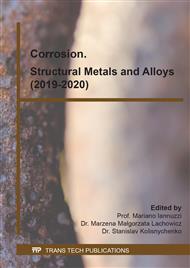[1]
Angelino G, Carbon Dioxide Condensation Cycles For Power Production, J. Eng. Gas Turbines Power. 90.3 (1968) 287.
DOI: 10.1115/1.3609190
Google Scholar
[2]
Yantovskii E I, Wall G, Lindquist L, et al, Exergonomics of the OCDOPUS project, Energy Convers. Manage. 34 (1993)1213-1218.
DOI: 10.1016/0196-8904(93)90071-h
Google Scholar
[3]
Mathieu P, Nihart R, Zero-emission MATIANT cycle, J. Eng. Gas Turbines Power. 121 (1999) 116-121.
DOI: 10.1115/1.2816297
Google Scholar
[4]
Iverson B D, Conboy T M, Pasch J J, et al, Supercritical CO2, Brayton cycles for solar-thermal energy, Appl. Energy. 111 (2013) 957-970.
DOI: 10.1016/j.apenergy.2013.06.020
Google Scholar
[5]
Ahn Y, Bae S J, Kim M, et al, Review of supercritical CO2, power cycle technology and current status of research and development, Nucl. Eng. Technol. 47 (2015) 647-661.
DOI: 10.1016/j.net.2015.06.009
Google Scholar
[6]
Crespi F, Gavagnin G, Sánchez D, et al, Supercritical carbon dioxide cycles for power generation: A review, Appl. Energy. 195 (2017) 152-183.
DOI: 10.1016/j.apenergy.2017.02.048
Google Scholar
[7]
Kumar P, Srinivasan K, Carbon dioxide based power generation in renewable energy systems, Appl. Therm. Eng. 109 (2016) 831-840.
DOI: 10.1016/j.applthermaleng.2016.06.082
Google Scholar
[8]
Li M J, Zhu H H, Guo J Q, et al, The development technology and applications of supercritical CO2, power cycle in nuclear energy, solar energy and other energy industries, Appl. Therm. Eng. 126 (2017) 255-275.
DOI: 10.1016/j.applthermaleng.2017.07.173
Google Scholar
[9]
Tan L, Anderson M, Taylor D, et al, Corrosion of austenitic and ferritic-martensitic steels exposed to supercritical carbon dioxide, Corros. Sci. 53 (2011) 3273-3280.
DOI: 10.1016/j.corsci.2011.06.002
Google Scholar
[10]
Nguyen T D, Xie Y, Ding S, et al, Oxidation Behavior of Ni–Cr Alloys in CO2, at 700 °C, Oxid. Met. 87 (2017) 1-12.
DOI: 10.1007/s11085-017-9721-9
Google Scholar
[11]
Nguyen T D, Zhang J, Young D J, Effect of Mn on oxide formation by Fe-Cr and Fe-Cr-Ni alloys in dry and wet CO2, gases at 650 °C, Corros. Sci. 112 (2016) 110-127.
DOI: 10.1016/j.corsci.2016.07.014
Google Scholar
[12]
Gong Y, Young D J, Kontis P, et al, On the breakaway oxidation of Fe9Cr1Mo steel in high pressure CO2, Acta Mater. 130 (2017) 361-374.
DOI: 10.1016/j.actamat.2017.02.034
Google Scholar
[13]
Rouillard F, Furukawa T. Corrosion of 9-12Cr ferritic–martensitic steels in high-temperature CO2, Corros. Sci. 105 (2016) 120-132.
DOI: 10.1016/j.corsci.2016.01.009
Google Scholar
[14]
Martinelli L, Desgranges C, Rouillard F, et al, Comparative oxidation behaviour of Fe-9Cr steel in CO2 and H2O at 550 °C: detailed analysis of the inner oxide layer, Corros. Sci. 100 (2015) 253-266.
DOI: 10.1016/j.corsci.2015.07.032
Google Scholar
[15]
Young D, Huczkowski P, Olszewski T, et al, Non-steady state carburisation of martensitic 9–12%Cr steels in CO2 rich gases at 550 °C, Corros. Sci. 88 (2014) 161-169.
DOI: 10.1016/j.corsci.2014.07.024
Google Scholar
[16]
Yu C, Nguyen T D, Zhang J, et al, Corrosion of Fe-9Cr-(Mn, Si) Alloys in CO2-H2O-SO2 Gases, Corros. Sci. 98 (2015) 516-529.
DOI: 10.1016/j.corsci.2015.05.040
Google Scholar
[17]
Liang Z, Yu M, Xu Z, et al, Influence of Low-Temperature Pre-oxidation by Ozone on Corrosion Resistance of T91 Steel in Steam at 600 °C, Oxid. Met. 1–2 (2018) 1-10.
DOI: 10.1007/s11085-018-9841-x
Google Scholar
[18]
Zhang D, Xu J, Zhao G, et al, Oxidation characteristic of ferritic-martensitic steel T91 in water-vapour atmosphere, Chin. J. Mater. Res. 22 (2008) 599-605.
Google Scholar
[19]
Saunders S R J, Monteiro M, Rizzo F, The oxidation behaviour of metals and alloys at high temperatures in atmospheres containing water vapour: A review, Prog. Mater. Sci. 53 (2008) 775-837.
DOI: 10.1016/j.pmatsci.2007.11.001
Google Scholar
[20]
Rahmel A, Einfluss von wasserdampf und kohlendioxyd auf die oxydation von nickel in sauerstoff bei hohen temperaturen, Corros. Sci. 5 (1965) 815-820.
DOI: 10.1016/s0010-938x(65)80011-7
Google Scholar
[21]
Zurek J, Quadakkers W J, Michalik M, et al, The Effect of Water Vapour Content and Gas Flow Rate on the Oxidation Mechanism of a 10%Cr-Ferritic Steels in Ar-H2O and Ar-H2-H2O mixtures, Appl. Surf. Sci. 288 (2005) 423-429.
DOI: 10.1007/s11085-005-4394-1
Google Scholar



